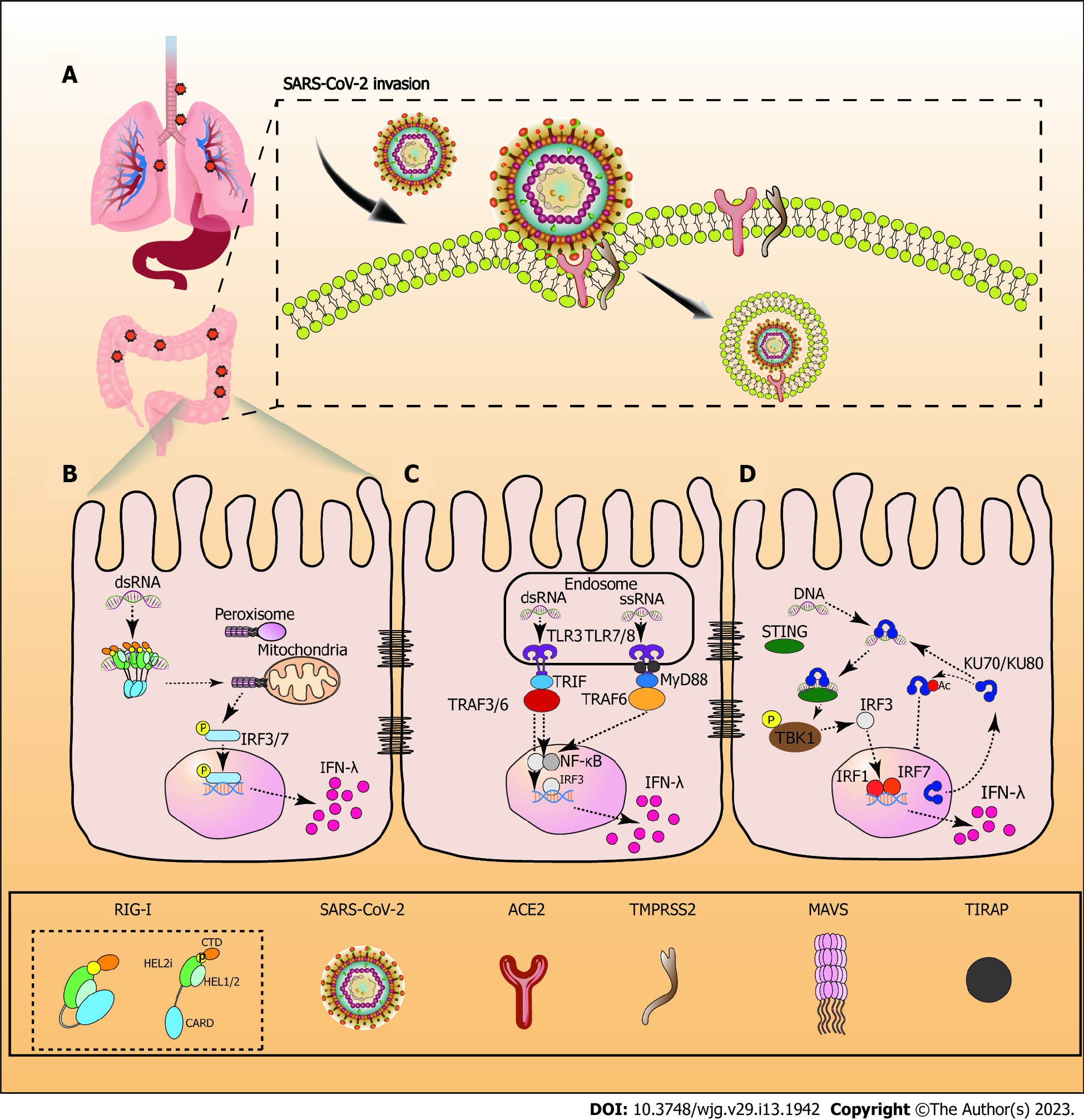Copyright
©The Author(s) 2023.
World J Gastroenterol. Apr 7, 2023; 29(13): 1942-1954
Published online Apr 7, 2023. doi: 10.3748/wjg.v29.i13.1942
Published online Apr 7, 2023. doi: 10.3748/wjg.v29.i13.1942
Figure 1 Infection mechanism of severe acute respiratory syndrome coronavirus-2 and retinotic acid-inducible gene 1.
A: Process of severe acute respiratory syndrome coronavirus-2 invasion in the gastrointestinal tract; B: Retinotic acid-inducible gene 1 (RIG-I) contains a pair of caspase activation and recruitment domains (CARDs), an ATPase motor domain (Helicase domain) that consists of two RecA domains (Hel1 and Hel2), and an alpha-helical insertion domain (Hel2i) connected via a Pincer motif (P) and a C-terminal domain. When RIG-I is in the inactivated state it clasps the CARDs against the surface of Hel2i. Once engaged with viral RNA, these pathogen RNAs trigger conformational changes that anchor the RNA tightly inside the RIG-I receptor and trigger the release of the CARDs[91]. Activated RIG-I interacts with mitochondrial antiviral signaling proteins to recruit phosphorylated interferon regulatory factor (IRF)3/7 in the nucleus, subsequently inducing interferon-λ (IFN-λ) production; C: Toll-like receptor (TLR) 3 interacts with dsRNA at opposite ends of the horseshoe ring in the endosome. TLR3 recruited TIR-domain-containing adapter-inducing interferon-β (TRIF) via the myeloid differentiation primary response 88 (MyD88) independent pathway. TRIF then recruits and activates the tumour necrosis factor receptor associated factor (TRAF) 3/6, inducing the recruitment of IRF3 and nuclear factor kB (NF-κB) in the nucleus. After TLR7/8 recognizes viral ssRNA in the endosome, the receptor-proximal membrane protein TIRAP detects the dimerized TIR domain of TLR7/8, and stimulates MyD88 to interact with it. MyD88 subsequently recruits TRAF6, leading to the recruitment of IRF3 and NF-κB in the nucleus. Once IRF3 binds to the promoter, IFN-λ gene expression is initiated[92,93]; D: Ku80 is co-localized with Ku70. Ku70 translocates from the nucleus to the cytoplasm, and recognizes cytosolic viral DNA. Subsequently, Ku70 with the DNA interacts with stimulator of interferon genes to phosphorylate TANK-binding kinase 1. Finally, IRF3 is activated, and produces the strong expression of IRF1and IRF7, which induce IFN-λ expression. Acetylation increases Ku70 accumulation in the cytoplasm and promotes DNA-mediated Ku70-dependent IFN-λ1 induction[94]. SARS-CoV-2: Severe acute respiratory syndrome coronavirus-2; IRF3/7: Interferon regulatory factor 3/7; IFN-λ: Interferon-λ; TRAF: Tumour necrosis factor receptor associated factor; TLR: Toll-like receptor; TRIF: TIR-domain-containing adapter-inducing interferon-β; NF-kB: Nuclear factor kB; TBK1: TANK-binding kinase 1; STING: Stimulator of interferon genes; MyD88: Myeloid differentiation primary response 88.
Figure 2 When interferon-λ is recognized in intestinal epithelial cells, JAK1 and TYK2 phosphorylate and activate phosphorylated signal transducer and activator of transcription 1 and signal transducer and activator of transcription 2.
Interferon (IFN)-stimulated gene factor 3 is formed by phosphorylated signal transducer and activator of transcription 1, signal transducer and activator of transcription 2, and interferon regulatory factor 9. It then binds to IFN-stimulated response elements in the nucleus to promote the transcription of IFN-stimulated genes (ISGs). ISGs inhibit the RNA replication of severe acute respiratory syndrome coronavirus-2 (SARS-CoV-2). Recognition of IFN-λ in naïve T cells promotes the differentiation of Th1 cells while inhibiting Th2 cells, resulting in increased IFN-γ and lower interleukin (IL)-13. In peripheral mononuclear blood cells (PMBCs), IFN-λ induces higher IL-6 and IL-8, while reducing IL-10. The effects of IFN-λ on naïve T cells and PMBCs enhance the antiviral effect of ISGs in intestinal epithelial cells. IFN-λ and pathogens are co-recognized by naïve B cells, and promote the differentiation of naïve B cells to plasmablasts through the phosphoinositide 3-kinase-phosphoinositide dependent kinase-1 pathway. This action produces large amounts of immunoglobulin M (IgM). IgM acts as a neutralizing antibody in the intestinal tract of SARS-CoV-2 infection. STAT1: Signal transducer and activator of transcription 1; STAT2: Signal transducer and activator of transcription 2; IL: Interleukin; IFN-λ: Interferon-λ; IEC: Intestinal epithelial cell; ISGF3: IFN-stimulated gene factor 3; IRF9: Interferon regulatory factor 9; ISRE: IFN-stimulated response element; ISG: IFN-stimulated genes; PI3K: Phosphoinositide 3-kinase; PDK1: Phosphoinositide dependent kinase-1; mTORC1: Mechanistic target of rapamycin complex 1; IgM: Immunoglobulin M.
- Citation: Pan YY, Wang LC, Yang F, Yu M. Interferon-lambda: New role in intestinal symptoms of COVID-19. World J Gastroenterol 2023; 29(13): 1942-1954
- URL: https://www.wjgnet.com/1007-9327/full/v29/i13/1942.htm
- DOI: https://dx.doi.org/10.3748/wjg.v29.i13.1942










